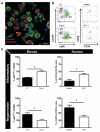BMP Receptor Inhibition Enhances Tissue Repair in Endoglin Heterozygous Mice
- PMID: 33670533
- PMCID: PMC7922601
- DOI: 10.3390/ijms22042010
BMP Receptor Inhibition Enhances Tissue Repair in Endoglin Heterozygous Mice
Abstract
Hereditary hemorrhagic telangiectasia type 1 (HHT1) is a severe vascular disorder caused by mutations in the TGFβ/BMP co-receptor endoglin. Endoglin haploinsufficiency results in vascular malformations and impaired neoangiogenesis. Furthermore, HHT1 patients display an impaired immune response. To date it is not fully understood how endoglin haploinsufficient immune cells contribute to HHT1 pathology. Therefore, we investigated the immune response during tissue repair in Eng+/- mice, a model for HHT1. Eng+/- mice exhibited prolonged infiltration of macrophages after experimentally induced myocardial infarction. Moreover, there was an increased number of inflammatory M1-like macrophages (Ly6Chigh/CD206-) at the expense of reparative M2-like macrophages (Ly6Clow/CD206+). Interestingly, HHT1 patients also showed an increased number of inflammatory macrophages. In vitro analysis revealed that TGFβ-induced differentiation of Eng+/- monocytes into M2-like macrophages was blunted. Inhibiting BMP signaling by treating monocytes with LDN-193189 normalized their differentiation. Finally, LDN treatment improved heart function after MI and enhanced vascularization in both wild type and Eng+/- mice. The beneficial effect of LDN was also observed in the hind limb ischemia model. While blood flow recovery was hampered in vehicle-treated animals, LDN treatment improved tissue perfusion recovery in Eng+/- mice. In conclusion, BMPR kinase inhibition restored HHT1 macrophage imbalance in vitro and improved tissue repair after ischemic injury in Eng+/- mice.
Keywords: endoglin; hind limb ischemia; myocardial infarction; neovascularization; tissue repair; transforming growth factor-β.
Conflict of interest statement
The authors declare no conflict of interest.
Figures







Similar articles
-
Inhibiting DPP4 in a mouse model of HHT1 results in a shift towards regenerative macrophages and reduces fibrosis after myocardial infarction.PLoS One. 2017 Dec 18;12(12):e0189805. doi: 10.1371/journal.pone.0189805. eCollection 2017. PLoS One. 2017. PMID: 29253907 Free PMC article.
-
Endoglin has a crucial role in blood cell-mediated vascular repair.Circulation. 2006 Nov 21;114(21):2288-97. doi: 10.1161/CIRCULATIONAHA.106.639161. Epub 2006 Nov 6. Circulation. 2006. PMID: 17088457
-
The ENG/VEGFα Pathway Is Likely Affected by a Nonsense Variant of Endoglin (ENG)/CD105, Causing Hereditary Hemorrhagic Telangiectasia Type 1 (HHT1) in a Chinese Family.Genes (Basel). 2024 Feb 27;15(3):304. doi: 10.3390/genes15030304. Genes (Basel). 2024. PMID: 38540362 Free PMC article.
-
Endothelial cell biology of Endoglin in hereditary hemorrhagic telangiectasia.Curr Opin Hematol. 2018 May;25(3):237-244. doi: 10.1097/MOH.0000000000000419. Curr Opin Hematol. 2018. PMID: 29438260 Review.
-
Hereditary hemorrhagic telangiectasia, a vascular dysplasia affecting the TGF-beta signaling pathway.Clin Med Res. 2006 Mar;4(1):66-78. doi: 10.3121/cmr.4.1.66. Clin Med Res. 2006. PMID: 16595794 Free PMC article. Review.
Cited by
-
Genome-wide DNA methylation dynamics in carbon tetrachloride-induced mice liver fibrosis.Iran J Basic Med Sci. 2023 Jan;26(1):85-92. doi: 10.22038/IJBMS.2022.66256.14555. Iran J Basic Med Sci. 2023. PMID: 36594057 Free PMC article.
-
Arteriogenesis and Therapeutic Angiogenesis-An Update.Int J Mol Sci. 2021 Dec 9;22(24):13244. doi: 10.3390/ijms222413244. Int J Mol Sci. 2021. PMID: 34948041 Free PMC article.
References
-
- Pérez-Gómez E., Jerkic M., Prieto M., Del Castillo G., Martín-Villar E., Letarte M., Bernabeu C., Pérez-Barriocanal F., Quintanilla M., López-Novoa J.M. Impaired wound repair in adult endoglin heterozygous mice associated with lower NO bioavailability. J. Investig. Dermatol. 2014;134:247–255. doi: 10.1038/jid.2013.263. - DOI - PubMed
-
- Peter M.R., Jerkic M., Sotov V., Douda D.N., Ardelean D.S., Ghamami N., Lakschevitz F., Khan M.A., Robertson S.J., Glogauer M., et al. Impaired resolution of inflammation in the endoglin heterozygous mouse model of chronic colitis. Mediat. Inflamm. 2014;2014:1–13. doi: 10.1155/2014/767185. - DOI - PMC - PubMed
-
- van Laake L.W., van den Driesche S., Post S., Feijen A., Jansen M.A., Driessens M.H., Mager J.J., Snijder R.J., Westermann C.J.J., Doevendans P.A., et al. Endoglin has a crucial role in blood cell-mediated vascular repair. Circulation. 2006;114:2288–2297. doi: 10.1161/CIRCULATIONAHA.106.639161. - DOI - PubMed
MeSH terms
Substances
Grants and funding
LinkOut - more resources
Full Text Sources
Other Literature Sources
Medical
Molecular Biology Databases

